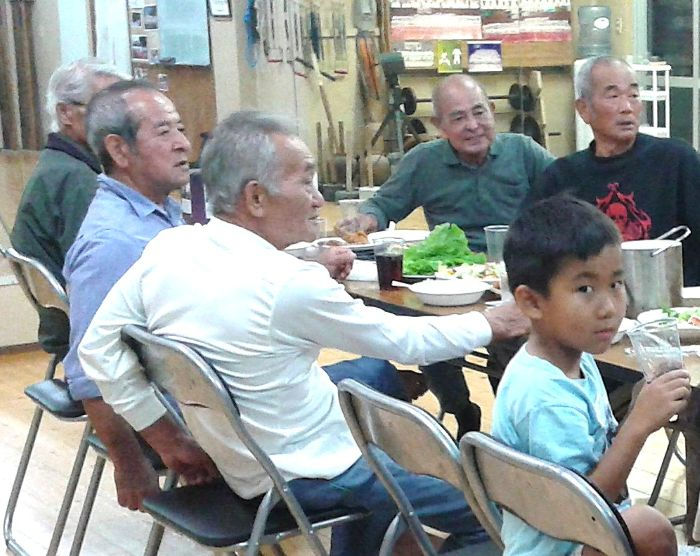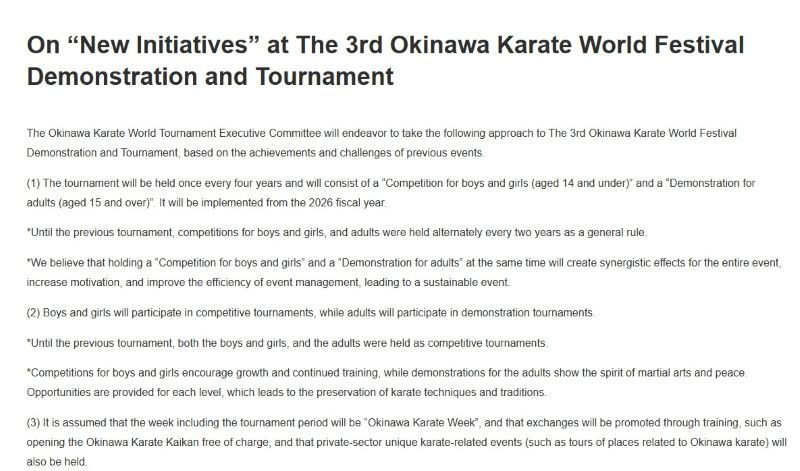Looking Ahead: The Future of Okinawan Karate
- OGKK Australia

- Aug 27
- 4 min read
I received news today about the upcoming 3rd Okinawa Karate Tournament and it’s a biggy! Starting in 2026, adults will no longer be able to compete, instead, they’ll only be able to take part in demonstrations, while the competitive side will be left entirely to children and teenagers. Now normally, I’m not a fan of tournaments. Honestly, they’ve never really done much for me. But this one actually meant something. Why? Well, it all started about eight years ago when my kobudo sensei asked me to compete in the 1st World Okinawa Karate Tournament. It’s always hard to say No to such a good-hearted gentleman, and surprisingly, the overall event was pretty pain-free and enjoyable. The rules too also made sense for once:
You had to perform an Okinawan version of a kata, none of the mainland style, watered-down versions which would have resulted in penalties.
Speaking of, you also got penalised for those dragged-out, over-the-top kiai. Yeah, the ones that sound like a heavy smoker is giving birth to twins. In other tournaments this kind of nonsense would get rewarded.
And best of all, the tournament felt like a subtle but satisfying ‘F-U’ to the non-Okinawan karate groups claiming Okinawan roots and somehow convincing others to believe it....(Japanese Olympic Team cough cough)
So yeah, even though I usually couldn’t care less about tournaments, this one carried a different weight. It wasn’t just about medals or showing off but reminded the world that Okinawa is still the heart of karate, not just the place tourists visit to say they’ve “seen the birthplace.”
So after having an online group chat today with the usual karate mates, we came up with a little analysis of the situation. When you look closer, the reasoning may reflect deeper cultural, and even generational concerns about karate’s identity and future.
A Generational Concern
A lot of senior Okinawan masters, people of our sensei’s generation and even the “younger seniors” (the ones in their 50s and 60s, with greying patches of hair) could be genuinely worried that karate is slowly dying in Okinawa. The fear that Okinawa will stop being the living home of karate and instead become a tourist postcard: “Here’s where karate was born… now please take a selfie and move along.” Without actively passing down the traditions, Okinawa risks being remembered only as the birthplace of karate, while the art itself spreads overseas, mutates, and ends up in hired halls where the closest thing to a proper kata is whatever someone picked up on YouTube.
Enter the Okinawan prefectural government. They’ve most likely noticed that karate isn’t just a martial art, it’s a big-ass cultural cash cow. Demonstrations, heritage tours, and “Okinawa Karate Week” aren’t just about preserving history; they’re about making sure tourists, journalists, and Instagram influencers leave thinking Okinawa is still the fully-sic land of karate, instead of just a scenic backdrop for some dickhead doing a karate pose on the beach. Okinawa may be in a full-on “protect the legacy” mode at the moment. Maybe part preservation, part PR stunt, and 100% ensuring the island doesn’t get reduced to a museum gift shop selling Shureido steak knives....Who knows?!

Sumo Similarities
A mate in the group chat mentioned that it reminded him of how sumo has adapted. He reckons many of today’s top sumo wrestlers (Rikishi) are from Mongolia, Eastern Europe, or parts of the world you didn’t even know had wrestling. Yet despite the global invasion, sumo has somehow kept its soul intact. The ceremonies, rituals, and cultural stuff are just as important as the bouts themselves, and nobody seems to dare touch that. Perhaps the Okinawan masters are hoping for the same path. Karate may continue to spread worldwide, mutate into TikTok-friendly monstrosities, and get taught like an AMWAY business model, but Okinawa will hopefully remain the cultural and spiritual heart of the art. These demonstrations taking the place of competition next year, may serve as a reminder of where it came from and what it’s supposed to stand for….(or maybe not haha)
So let’s quickly talk about the future too shall we?
It’s going to be fascinating to watch this unfold over the next 20 years. Me mate also gave the view that the kids competing now will have to grow up juggling both sides of karate: the thrill of competition and the weighty, sometimes painfully serious, grounding of tradition. As they become teachers and leaders in the future, they’ll have to carry both perspectives, hopefully preventing karate from turning into a global circus of Instagram clout.
The removal of adult competition for many may sting at first, but maybe, just maybe, it’s a carefully calculated masterstroke. It puts Okinawan karate where it belongs: not in the petty arena of “who’s better,” but in the realm of tradition, cultural preservation, and making sure no dickhead ruins it on a beach for a seipai selfie.

Or click on the official link for original post.....




Comments